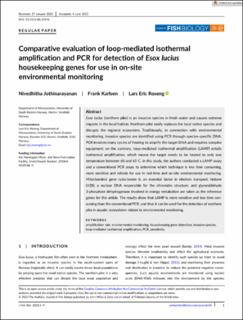Comparative evaluation of loop-mediated isothermal amplification and PCR for detection of Esox lucius housekeeping genes for use in on-site environmental monitoring
Peer reviewed, Journal article
Published version
Permanent lenke
https://hdl.handle.net/11250/3127039Utgivelsesdato
2023Metadata
Vis full innførselSamlinger
- Institutt for mikrosystemer [546]
- Publikasjoner fra CRIStin [3623]
Originalversjon
Jothinarayanan, N., Karlsen, F., & Roseng, L. E. (2023). Comparative evaluation of loop-mediated isothermal amplification and PCR for detection of Esox lucius housekeeping genes for use in on-site environmental monitoring. Journal of Fish Biology, 103(5), 897-905. https://doi.org/10.1111/jfb.15476Sammendrag
Esox lucius (northern pike) is an invasive species in fresh water and causes extreme impacts in the local habitat. Northern pike easily replaces the local native species and disrupts the regional ecosystem. Traditionally, in connection with environmental monitoring, invasive species are identified using PCR through species-specific DNA. PCR involves many cycles of heating to amplify the target DNA and requires complex equipment; on the contrary, loop-mediated isothermal amplification (LAMP) entails isothermal amplification, which means the target needs to be heated to only one temperature between 60 and 65°C. In this study, the authors conducted a LAMP assay and a conventional PCR assay to determine which technique is less time consuming, more sensitive and reliable for use in real-time and on-site environmental monitoring. Mitochondrial gene cytochrome b, an essential factor in electron transport; histone (H2B), a nuclear DNA responsible for the chromatin structure; and glyceraldehyde 3-phosphate dehydrogenase involved in energy metabolism are taken as the reference genes for this article. The results show that LAMP is more sensitive and less time consuming than the conventional PCR, and thus it can be used for the detection of northern pike in aquatic ecosystems related to environmental monitoring.

